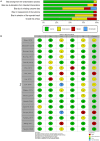Effectiveness of Virtual Reality in the Rehabilitation of Motor Function of Patients With Subacute Stroke: A Meta-Analysis
- PMID: 34025553
- PMCID: PMC8131676
- DOI: 10.3389/fneur.2021.639535
Effectiveness of Virtual Reality in the Rehabilitation of Motor Function of Patients With Subacute Stroke: A Meta-Analysis
Abstract
Stroke is a major cause of death and disability in adults. Conventional therapy (CT) has limited effectiveness, and therefore, various virtual reality (VR) rehabilitation programs have been designed. However, their efficacy in regaining motor function in patients with subacute stroke is questionable. Therefore, we conducted this meta-analysis to determine the efficacy of VR, compared to CT, in restoring motor function in this patient population. Up to October 10, 2020, nine electronic databases were searched for relevant articles reporting the effectiveness of VR in regaining motor function in patients with subacute stroke. This search was updated on March 7, 2021, with no additional added articles. The control group included CT, physical therapy, occupational therapy, or a combination of them. Effectiveness is defined as the positive change from baseline values to the last follow-up point. The Cochrane's revised risk-of-bias tool was used to determine the quality of included trials. A metaregression analysis was conducted to determine the effect of "time since last stroke" on reported outcomes. Publication bias and sensitivity analyses were also carried out. A total of 19 studies (17 randomized controlled trials, 1 cohort study, and 1 crossover trial) were included in the qualitative analysis, whereas 16 trials were meta-analyzed. A great improvement in motor function was noted in the VR group, when compared to preintervention values [standardized mean difference (SMD) = 1.14; 95% confidence interval (CI) = 0.77-1.52; I 2 = 82%; P < 0.001]. When compared to CT, VR resulted in mild improvement in motor function (SMD = 0.47; 95% CI = 0.22-0.72; I 2 = 75%; P < 0.001). However, upon trim-and-fill adjustment, this finding was deemed insignificant (SMD = 0.08; 95% CI = -0.16 to 0.33; I 2 = 82.6%; P < 0.001). Ten studies had low risk, five had some concerns, three had high risk, and one had a moderate risk of bias. VR programs can be used jointly with CT for the rehabilitation of the motor function of patients with subacute stroke. However, more studies are still warranted to determine the effectiveness of these interventions in retaining the cognitive function and physical performance of such patients.
Keywords: conventional therapy 3; meta; rehabilitation; subacute stroke; virtual reality.
Copyright © 2021 Peng, Yin and Cao.
Conflict of interest statement
The authors declare that the research was conducted in the absence of any commercial or financial relationships that could be construed as a potential conflict of interest.
Figures






Similar articles
-
Virtual Reality Systems for Upper Limb Motor Function Recovery in Patients With Spinal Cord Injury: Systematic Review and Meta-Analysis.JMIR Mhealth Uhealth. 2020 Dec 3;8(12):e22537. doi: 10.2196/22537. JMIR Mhealth Uhealth. 2020. PMID: 33270040 Free PMC article.
-
Examining the effect of virtual reality therapy on cognition post-stroke: a systematic review and meta-analysis.Disabil Rehabil Assist Technol. 2022 Jan;17(1):50-60. doi: 10.1080/17483107.2020.1755376. Epub 2020 May 2. Disabil Rehabil Assist Technol. 2022. PMID: 32363955
-
Effect of Time-Dose-Matched Virtual Reality Therapy on Upper Limb Dysfunction in Patients Poststroke: A Meta-Analysis of Randomized Controlled Trials.Arch Phys Med Rehabil. 2022 Jun;103(6):1131-1143.e7. doi: 10.1016/j.apmr.2021.09.003. Epub 2021 Oct 4. Arch Phys Med Rehabil. 2022. PMID: 34619141 Review.
-
Evaluating the effect and mechanism of upper limb motor function recovery induced by immersive virtual-reality-based rehabilitation for subacute stroke subjects: study protocol for a randomized controlled trial.Trials. 2019 Feb 6;20(1):104. doi: 10.1186/s13063-019-3177-y. Trials. 2019. PMID: 30728055 Free PMC article.
-
New technologies promoting active upper limb rehabilitation after stroke: an overview and network meta-analysis.Eur J Phys Rehabil Med. 2022 Aug;58(4):530-548. doi: 10.23736/S1973-9087.22.07404-4. Epub 2022 Jun 6. Eur J Phys Rehabil Med. 2022. PMID: 35666491 Free PMC article. Review.
Cited by
-
Overground Walking in a Fully Immersive Virtual Reality: A Comprehensive Study on the Effects on Full-Body Walking Biomechanics.Front Bioeng Biotechnol. 2021 Dec 3;9:780314. doi: 10.3389/fbioe.2021.780314. eCollection 2021. Front Bioeng Biotechnol. 2021. PMID: 34957075 Free PMC article.
-
Effects of Virtual Reality-Based Intervention on Cognition, Motor Function, Mood, and Activities of Daily Living in Patients With Chronic Stroke: A Systematic Review and Meta-Analysis of Randomized Controlled Trials.Front Aging Neurosci. 2021 Dec 13;13:766525. doi: 10.3389/fnagi.2021.766525. eCollection 2021. Front Aging Neurosci. 2021. PMID: 34966267 Free PMC article. Review.
-
Effects of Virtual Reality on the Limb Motor Function, Balance, Gait, and Daily Function of Patients with Stroke: Systematic Review.Medicina (Kaunas). 2023 Apr 21;59(4):813. doi: 10.3390/medicina59040813. Medicina (Kaunas). 2023. PMID: 37109769 Free PMC article. Review.
-
Merging virtual and physical experiences: extended realities in cardiovascular medicine.Eur Heart J. 2023 Sep 14;44(35):3311-3322. doi: 10.1093/eurheartj/ehad352. Eur Heart J. 2023. PMID: 37350487 Free PMC article. Review.
-
Stroke rehabilitation: from diagnosis to therapy.Front Neurol. 2024 Aug 13;15:1402729. doi: 10.3389/fneur.2024.1402729. eCollection 2024. Front Neurol. 2024. PMID: 39193145 Free PMC article. Review.
References
Publication types
LinkOut - more resources
Full Text Sources

